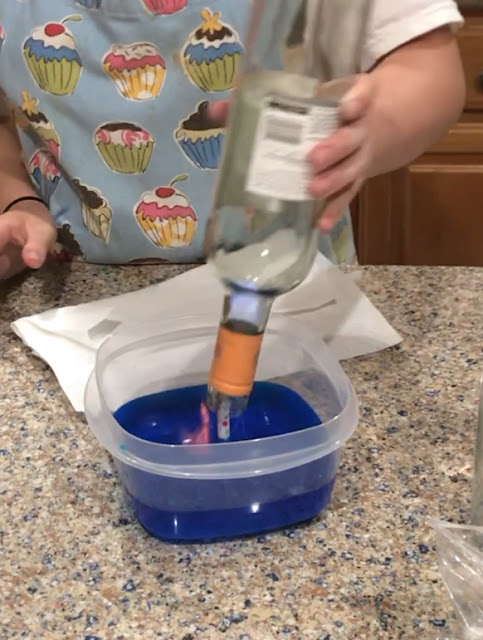I'm going to start this experiment with a technical description of what we are doing here. I had to divine this before I could make the wildly different and terse internet "recipes" work. A few little tricks required my knowledge of what was happening as it relates to crystallization, enthalpy of fusion, and the exact reaction entailed. I had tried previously but failed. I had a good idea of what was happening, but not good enough to fully anticipate next steps along the way. It turned out to be a bit tricky, but I think my description here should be complete enough for others.
I have to admit this is the most amazing experiment that I have done, even more than I anticipated. If you want the Gee-whiz without any technical details, like an old BASIC program, GOTO EXCITING_STUFF_HERE
Otherwise...
BORING STUFF HERE:
We are going to supercool a solution, and then apply a seed crystal, causing it to almost instantly crystallize the whole liquid into a solid and release heat upon fusing.
First, we create a solution of sodium acetate in water. No big deal, every kid knows what happens when you mix 3 tablespoons (54g) of basic baking soda and 3 cups (750ml) of 5% acidic vinegar. You get a reaction with a lot of carbon dioxide bubbling, so you have to add the vinegar slowly.
5% Vinegar has 5g of pure acetic acid (CH3COOH) for every 100ml of solution. You can adjust the amount for your concentration.
Baking soda is NaHCO3
At this point we have created CH3COONa (sodium acetate) dissolved in a bunch of water with a big release of carbon dioxide.
After it is fully reacted, put the pot on the stove on low heat. You need to get the solution well above 136 degrees and leave it there, while evaporating most of the water away. Our goal is a simmering solution (less than 212F, say 190F) with exactly enough water left to form three water molecules for every sodium acetate molecule. Exactly, more or less. :)
CH3COOH + NaHCO3 + 2H2O -> CH3COONa*3H2O + CO2
Why 136 degrees? That is the "freezing temperature" below which sodium acetate trihydrate (a crystal with the three waters included) can form. In other words, this compound is normally a solid at room temperature. By keeping it hot, we can keep these crystals melted as long as we have enough water in our solution.
Why 190F? Water boils at 212F, so our solution should boil just above that point. It is hard to see what is going on in your dish with a raging boil. Also, we will need to cool it later, so overheating seems unnecessary. OK, I warn you now, we are getting rid of about 90% of the water, and it has to be done precisely. This can take hours and frankly I don't have the patience. My shortcuts usually led to failure.
This one did work. I found that I could bring it up to a low or moderate boil periodically, but needed to check my volume and make sure my solution was still clear by turning down the heat every few minutes. Once you are below a cup of solution, you should watch more carefully and avoid the boil. Note that white crystals start forming on the sides of the pan early on. This is normal and expected. Ignore them.
After an hour and a half or so I saw an unexpected white powder forming in the bottom of the solution. I have no idea what this was. In theory, my 1 TBL for every 1 cup formula gave me about 2g too much baking soda. Did this somehow appear when there was no longer enough water to dissolve it? I think so. I had it happen twice, and I am pretty sure it was not crystallization. If it was not baking soda, it was most likely anhydrous sodium acetate which is not the exact chemical structure that we need.
The first time I made the mistake of thinking it was the desired crystallization and proceeding to drain and filter my solution for cooling. Don't do this. The second time I drained the solution and filtered the white powder out, but then rinsed my dish and put it back in there to keep simmering. This is what to do if you get the white powder formation. I suppose I could have also added some vinegar until it went away, but then I'd have even more water to evaporate away (assuming a healthy dilution). In any case, the powder never came back or reformed. It is possible that I could have proceeded to crystallization (described below) while the powder hung around. I am not sure as I did not test this.
About two hours into the process, on a nice 190F simmer of my especially clear solution, I noticed crystals forming. The key is knowing what to look for and catching it quickly. The way they form is a small clear crust just beginning to form on the surface of the water like a scum. You really can't miss it, it is not like a precipitate down in the solution. Now when this happens, act immediately. Turn off the burner, and slowly pour the hot solution through a filter into your clean dish again.
It is critical that the dish be cleaned well after prior uses. I used a funnel and a coffee filter. Still, it is hot and the filter drains slowly. You want to catch any impurities or crystals and keep them outside of your solution. In my case, I had a nice clear yellowish liquid, between a quarter and a third of a cup, that had cooled to about 150F degrees (this needs to stay above 137F for now). Quickly I added plastic wrap to the top of my dish (to prevent further evaporation) and carefully placed it into my refrigerator where it would not get bumped. Now, you can use room temperature to supercool the solution, but the fridge is faster and we are 2+ hours in at this point.

Supercooling is lowering the temperature to below the freezing level but without fusion (crystallization) occurring. Think water at less than 32F but not frozen. We do not want the phase change to solid to happen just yet. In this case, getting it to room temperature (about 60F below the point of fusion) is fine. Unlike supercooling water, we don't need to get it below 30F, and that is one reason this crystal is perfect for our experiment. Another reason is this chemical has a high latent heat of fusion, which means that it releases a lot of energy upon fusion (or takes a lot to melt). A supercooled liquid can "store" the energy required for crystallization to be released later in the form of heat. Obviously, a "frozen" phase of any substance is in a lower energy state than a liquid or gas where parts are expanding and moving about (more disorder is higher entropy).
Another thing I had to learn is that heated water is a better solvent than unheated water. By heating our solution to 190F, we can dissolve a larger amount of chemical in our solution than at room temperature. When the solution is fully saturated then cools without crystallization, it becomes supersaturated. The liquid contains more dissolved chemicals than would have been possible without heating. This was an ah-ha moment for me, as I realized it was critical that we fully saturate the heated solution and no more. We needed crystals to form (the moment of full saturation) before stopping the dehydration.
At this point, taking time to clean the dishes while the solution supercooled in the refrigerator, I was ready for the good part. The solution still looked clear and liquid, and I was able to move it to the counter without accidentally kicking off the crystallization. Supercooled liquids are not very stable, and even a bump can start their fusion sometimes. What works best is nucleation, or the introduction of a "seed" crystal to which the remaining chemicals can readily bond. I was prepared with seed crystals scraped from the bottom of the pot after pouring out the final solution.
While I had planned to drop a seed crystal in, I wanted to measure the temperature of my supercooled solution. So I inserted the tip of a candy thermometer. Before I could read a temperature, a reaction formed around the tip of the probe and started expanding outwards as white crystal. I had provided just enough nucleation in the form of disturbance and/or the introduced probe. I quickly pulled the thermometer out to get my camera, and the reaction stopped, leaving me with a nice seed on the tip of a thermometer probe. What luck! While I could not get a temperature of the solution because the crystallization releases energy in the form of heat, I had a nice seed on the end of a probe that could measure the heat of the reaction.
Lights, camera, action! You can see the rest below... I should note that the heat of my fusion was 120F. It makes sense that it was not quite enough energy to melt it again.
EXCITING_STUFF_HERE:
This experiment "supercools" a liquid. When I dip a bit of the type of crystal ("hot ice") that should form, a beautiful 3D upside-down chrysanthemum-like growth initiates and completes in less than 20 seconds, leaving nothing but a warm solid mass of crystals in my bowl. It is like a magic trick. Here it is in video:
And here is a closeup of the solid. The solution shrank a bit to fill almost exactly 1/4 cup of solid in the end:
And here are recovered crystals outside the dish:
Isn't that super cool?
Thanks for reading,
Paul




































